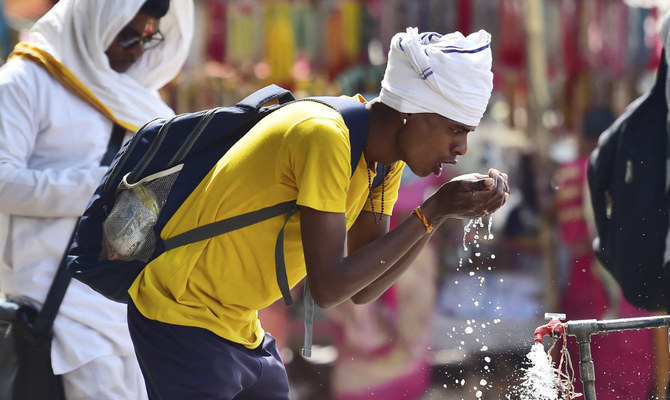INDIA must be prepared for more intense heat waves to come, the country’s meteorological department told Arab News, as the South Asian nation recorded unusual heat in April along with other countries in the region.
Large parts of Asia, from India to southern China to Thailand, was enveloped for weeks with intense heat waves that set in unusually early this year. Though April is typically one of the warmest months, 2023 saw countries including Laos, Thailand and Myanmar experiencing their highest recorded temperatures of between 42 C to more than 45 C.
Temperatures in India’s Prayagraj district and eastern Odisha state had exceeded 44 C in mid-April, while at least 13 people died and more than 50 others taken to hospital from heatstroke in the western Maharashtra state.
“You must prepare yourself. Be sure that carbon emission is not getting reduced in the coming decade so the intensity of the heat wave will increase further,” K. J. Ramesh, director general of meteorology at the India Meteorological Department, told Arab News.
Heat waves are common between March and July in the country, but the hot spells have become more intense, more frequent and longer in recent years.
“This heat wave has been happening for the last four or five years because of global warming and this is an unusual heat wave.”
India and Pakistan saw more severe heat waves in 2022, recording the highest March temperatures since records began over 120 years ago, but the scorching April heat this year appears to have affected a much wider area.
The Indian Meteorological Department is expecting above-average temperatures and heat waves until the end of May.
Some Indian states have begun mitigation efforts, Ramesh said, including closing schools by 1 p.m., operating government offices between 7am and 1pm and issuing advisories for seniors and youths to keep indoors between 11 a.m. and 3 p.m.
India’s agriculture, economy, and public health are bearing “unprecedented burdens” due to climate change-induced heat waves, a study published in the Public Library of Science last month showed.
Last year, they cost India’s grain-growing state of Punjab 25 percent of its yield, the Indian Farmers’ Union said.
“This year too due to unseasonal rain caused by the heat wave, the crop has got substantially damaged,” Jagmohan Singh Patiala, general secretary of the union, told Arab News.
“The problem is that we cannot change crops and resort to short- term crops so easily. The government has to take initiative and think of farmers,” he said.
S. Janakarajan, a former professor at Madras Institute of Development Studies, said global warming was not the only culprit. Urbanisation was also to blame, he said.
“You cannot put the entire blame on climate change. This is what we call ‘hiding behind climate change,’” Janakarajan told Arab News.
Urbanisation, Janakarajan said, appears to be a “never-ending phenomenon.”
“All over the world, cities are urbanising and expanding more and more. More people are coming to cities to live. More people are going to live in cities than rural areas.
Impact is going to be high,” he said.
More buildings and other urban infrastructures mean fewer green spaces and water bodies, he added. Concrete, meanwhile, absorbs heat and releases it slowly.
“Constructing more high-rises means that you are cutting down ventilation in the city. When open ventilation comes down and when there is no free flow of air from one place to another place then you call it a heat island,” Janakarajan said.
“The number of heat islands go up, the number of buildings go up, tar roads go up — all these contribute heat.
“Countries should understand that growth is not unlimited, growth has its own limits. A sustainable future should be the future.”
